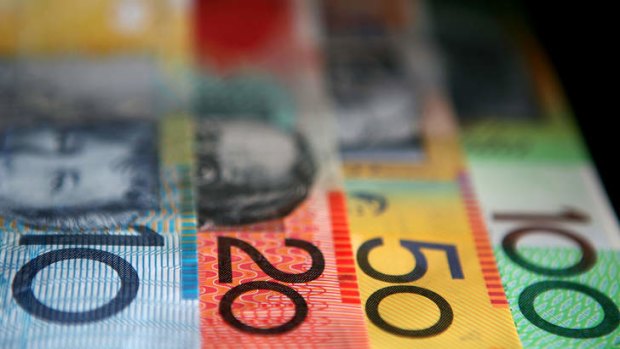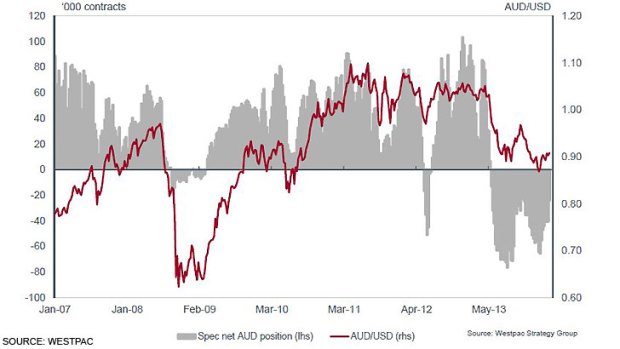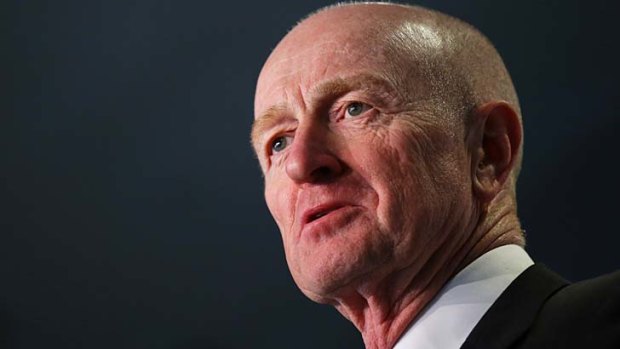This was published 10 years ago
Australian dollar to fly higher but resurgent greenback will clip its wings
By Glenda Kwek
The Australian dollar is tipped to strengthen beyond its fresh highs but will be held in check by a resurgent US dollar, currency experts say.
The Australian dollar hit four-month highs late Wednesday, building on the surge that followed Reserve Bank governor Glenn Stevens' comments on his upbeat outlook for the local economy in a speech in Hong Kong on Wednesday.

Australian dollar .... second-best performing G10 currency against the US dollar this year.Credit: Ian Waldie
But its recent appreciation, which has seen it rise more than 3 per cent this year, is not set to bring the currency back to the parity levels of early 2013. Instead, the recovery in the US economy is expected to gradually boost the American dollar and restrain the Australian currency's rise.
The Australian dollar pushed to US92.45¢ late Wednesday, in what analysts said was a marked shift away from the bearish sentiment that had weighed it down in 2013. It slipped slightly but rose again and was fetching US92.37¢ late Thursday.

Speculators are reducing their net short positions on the Australian dollar, according to data from the US-based Commodity Futures Trading Commission, which means they are less negative about its outlook.Credit: Westpac
"This week's price action has been very telling," said Westpac's senior currency strategist Sean Callow.
"The low for the week came on HSBC's China PMI (Purchasing Managers Index), which took us down to US90.50¢. And since then, it's been almost one-way traffic."
The preliminary PMI figures for March, which measure activity in China's manufacturing sector, were released on Monday and showed the industry had slowed down for the third-straight month.
But it also triggered market speculation that the Chinese government would step in to boost growth so that it can meet its 7.5 per cent GDP target for this year, which in turn fuelled optimism about the Australian dollar.

Reserve Bank governor Glenn Stevens ... no longer aggressively "jawboning" on the need for a weaker exchange rate.Credit: Bloomberg
Meanwhile, the Reserve Bank's shift to a neutral monetary policy stance in February, while flagging a period of stability in interest rates, was reaffirmed when Mr Stevens' outlined a positive outlook for the Australian economy at a high-profile speech at a Credit Suisse conference in Hong Kong on Wednesday.
Mr Stevens also refrained from jawboning on the need for a weaker exchange rate, as he and other RBA officials had down late last year.
These factors, coupled with the weakness of the US currency earlier this year after a spate of soft economic data on the back a severe winter, has reduced the negative outlook for the Australian dollar.
It's also seen the dollar become the second-best-performing G10 currency against the US dollar this year.
The rising exchange rate has caused investors to scramble out of their bearish bets on the Australian dollar, according to weekly data from the US-based Commodity Futures Trading Commission (CFTC). The futures contracts recorded by the CFTC are used to measure market sentiment on a currency.
Traders cut their net shorts by 25,643 contracts to 15,370 contracts in the week ended March 18, the second-biggest reduction on record, Bloomberg reported. Short positions are bets that an asset will fall.
"The latest data did show a notable reduction in short positions," Mr Callow said.
"The speculators have been very bearish on the Aussie since last May, which is an unusually long time for them. Normally they have moved on to other things. It just shows you how persistent this view has been that the Aussie must fall, even after it has fallen so far."
The shift in sentiment away from a bearish outlook has also been reflected in how global investors are once again taking an interest in local-currency-dominated assets, Macquarie Bank currency strategist David Forrester said.
"There is a bit more confidence in the Australian economy. And I think that is causing investors globally to look at Australian-dollar assets. We're likely seeing a pick-up in investor inflows into Australia," Mr Forrester said.
"Part of that confidence from buying Aussie assets come from two factors. The first one is that the Aussie fell about 15 per cent last year, so investors feel more comfortable that it's probably not overvalued by a significant amount. And the second one is that we no longer have a central bank talking down the currency."
Despite these supporting factors, the gradual appreciation of the Australian dollar this year is not sending strategists scrambling to factor in any possibility of a push towards parity.
While analysts said the local dollar could grind higher over the next few months, the expected strengthening of the US dollar as the American economy recovers will eventually push the exchange rate lower.
"Yes, we think it has more to run, it is more than just short covering, but I don't see it as a sustained long-term change in direction," Rochford Capital's director Thomas Averill said.
"When you seen the US exit its extremely low levels of interest rates, it's going to be for a ... well-telegraphed program, which is going to lead to a sustained recovery in the US dollar."
The eventual normalisation of US monetary policy could also be the reason why the Reserve Bank has appeared to be more comfortable with the Australian dollar's recent appreciation, said Mr Callow.
He pointed out that Mr Stevens clearly stated in his Hong Kong speech that tapering - the reduction of the US Federal Reserve's unprecedented stimulus program - was a good move for global economies.
"[The RBA] suspect the Aussie isn't just going to keep up rising because of what the Fed is up to," Mr Callow said. The chair of the Fed, Janet Yellen, said last week the central bank could wait only six months after ending its stimulus reduction to start raising interest rates.
"Stevens explicitly used the word 'welcome' for tapering in his speech. He is very much assuming that the US dollar does strengthen on the back of that normalisation of Fed policy, so this could just be a temporary bout of Aussie strength. Given some time ... the Aussie will come back anyway."